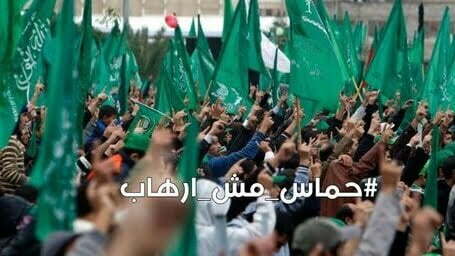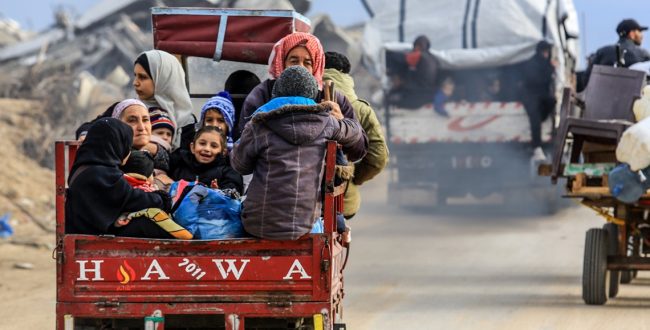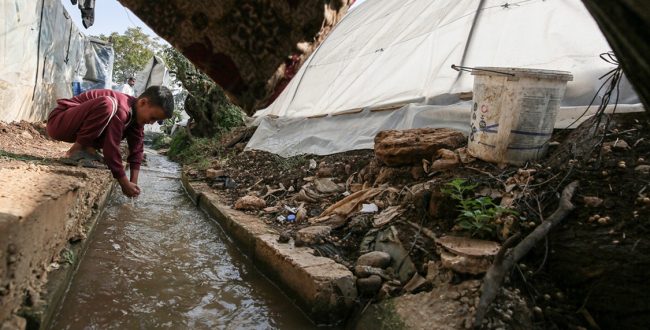background
Hamas ' sweeping victory in the Palestinian Legislative Council elections in January 2006 surprised not only the Israeli government but also the Palestinian Authority. President Mahmoud Abbas (Abu Mazen) immediately appointed Ismail Haniya as Palestinian prime minister, but his party, Fatah, refused to join the Haniya government as long as Hamas refused to accept the terms of the international quartet: recognition of Israel, recognition of the Oslo Accords and an end to the armed struggle.
A fierce battle that claimed hundreds of lives was fought between Fatah and Hamas during 2006. In May, Hamas Defense Minister Said Tsiam set up a new security apparatus, the " Operating Force ," with 5,000 operatives equipped with SUVs and Kalashnikov rifles. Compliance with the existing security mechanisms (most of which were staffed by Fatah members) to his instructions. Mahmoud Abbas outlawed the mechanism in January 2007. Thus, even before it actually took control of the Gaza Strip in June 2007, Hamas had already prepared the ground for security independence.
That same month, May 2006, the leaders of the Palestinian movements imprisoned in the Hadarim prison signed the "National Consensus Document , " known as the "Prisoners' Document." The document outlined for the first time the boundaries of the Palestinian political consensus: the establishment of an independent state within the Green Line with Jerusalem as its capital, and the realization of the right of return for refugees in 1948. The familiar roof of the Palestinians since the 1960s – PLO. The official adoption of the document was interrupted by the abduction of soldier Gilad Shalit from the Gaza border in June 2006 and the harsh Israeli punitive measures against Hamas that followed, including the imprisonment of 33 Hamas MPs.
Despite the fierce rivalry between Hamas and Fatah, which included arrests and mutual assassinations of security personnel, the parties agreed in March 2007 to form a unity government led by Ismail Haniya, following the signing of a reconciliation agreement in Mecca in February. Hamas violently took control of the Gaza Strip and expelled Fatah security forces in a series of attacks on government buildings in Gaza, which began on June 10, 2007. Five days and 118 deaths later, Hamas' takeover of the Gaza Strip was completed.
consolidation
Immediately after the removal of Fatah from the Gaza Strip, Hamas sought to impose its authority on the remaining opposition elements: the large clans of Damascus and Khales, and jihadist Salafist groups. Johnston was kidnapped in March by the jihadist group "Jaish al-Islam" led by Mumtaz Dughmush. Haniya posed triumphantly with journalist freed, and Hamas spokesman Fawzi Barhoum claimed that the release demonstrated the security capabilities of the movement: "In the past [in Gaza] 75,000 security personnel who failed to free Johnston, but Hamas did. "At the press conference, Haniya expressed his hope that the abducted soldier Gilad Shalit would also be released" in a respectable deal "as Johnston was released.
Clashes with the Damascus family and members of the Islamic Army continued in 2008. In September , Hamas police raided the family's homes in the al-Sabra neighborhood of western Gaza and tried to arrest two wanted men who had killed a police officer. In the clashes, 11 members of the clan were killed and 46 were injured, as well as a Hamas policeman. During the raid, Hamas confiscated small arms, RPG rockets, hand grenades and military equipment.
That same year , Abu Hefetz, the leader of the al-Qaeda-linked Jish al-Amma group in Gaza, appeared in the video , accusing Hamas of not implementing sharia in the Gaza Strip. Abu Hefetz, who has been arrested several times by Hamas, claims that Jish al-'Ama is ideologically connected to al-Qaeda, but not organizationally.
This was a prelude to the dramatic announcement by the leader of the Jand Ansar Allah group, Sheikh 'Abd al-Talif Musa, in August 2009 of the establishment of an Islamic emirate in the Gaza Strip during a speech at the Ibn Taymiyyah mosque in Rafah. The organization became famous for the first time when it tried to attack an IDF post at the Karni crossing in June of that year, an attack that failed and ended in the deaths of three of the organization's members. Inside the Strip, the organization attacked Internet cafes.
Hamas security forces surrounded Musa's mosque. A seven-hour firefight killed 24 Palestinians and injured more than 130. Musa himself killed a Hamas policeman while being caught in his home, and committed suicide using an explosive belt. Following the incident , jihadist elements in the Gaza Strip accused Hamas of "serving the interests of the Zionist occupiers in Palestine."
Hamas' ongoing attack on jihadist elements in the Gaza Strip led to the abduction of Italian journalist and peace activist Vittorio Arigoni in April 2011. The unidentified group that abducted Arigoni, the "Battalion of the Prophet Muhammad bin Masalma", demanded the release of all jihadist prisoners Headed by Sheikh Hashem Saidani, a prominent global jihadist. The hijackers attacked the Italian origins of Arigoni – an "infidel" country that they say continues to occupy Islamic lands.
Following the discovery of Arigoni's body on April 14, Hamas issued a stern condemnation, and Prime Minister Haniya called the activist's mother and expressed his sorrow. During a raid on the house of those suspected of kidnapping in the Nutsirat refugee camp, two jihadists were killed and four were arrested, as well as five Hamas policemen. At the request of Arigoni's family, the death sentence imposed on defendants was sentenced to life imprisonment.
Individual rule: ideology and practice
There are two main reasons why Hamas wants to crush its rivals in the Gaza Strip: an ideological motive and a practical-party motive. At the ideological level, Hamas opposes the Salafi-jihadist worldview, which sees the Middle East, and indeed the entire world, as a scene of constant struggle between Islam and the forces of heresy. Salafi Islam often uses the term "heresy", meaning that non-Muslims see infidels and mortals as long as they have not accepted the authority of Islam, while Hamas' agenda is fundamentally political. Most Muslim jurists oppose heresy, especially when it is directed against other Muslims, believing that only God examines kidneys and heart, and only he will judge human beings in the end times.
Politically, Hamas believes in a Palestinian nation-state living in the light of Islamic values within the borders of the British Mandate ("historic Palestine"), the same borders that Salafist jihadist organizations contemptuously call "Sykes-Picot borders" and are working hard to abolish them in favor of Islamic caliphates.
Religiously, the Salafist movements advocate purist Islam from the seminary of the medieval thinker Ibn Taymiyya. Ibn Taymiyya is the clear representative of the Hanbali school of halakhah, the rigid one of the Sunni halakhic schools in Islam. Ibn Tamiya's seminary advocates as accurate an imitation as possible of the Prophet Muhammad's way of life, and opposes Western innovations, such as music and literature. Hamas, on the other hand, is loyal to the ideology of the Muslim Brotherhood , and sees itself operating within the society in which it lives through positive religious conviction ("Dawa") and within the current political conditions.
Hamas' approach to the Salafi-jihadist ideology can be seen in a statement of condolence issued by the movement following the killing of a member of the Izz ad-Din al-Qassam Brigades, Nidal Jafari by a Salafi suicide bomber on the Egyptian border in August 2017. In a proclamation published by Hamas Jihadist "perverted ideology" ("disgraced peasant") and "foreign plant" ("dhil"). The proclamation presents Hamas as facing two enemies: Israel from the outside, and the Salafi-Jihadist ideology from within, a movement that attempts, by definition, to "divert the sacred jihad compass against the occupying Zionists."
The Hamas Interior Ministry in Gaza, which controls the security apparatus, has set up a "department for political and moral guidance." The purpose of the department is similar to the purpose of similar bodies in many armies in the Middle East: to instill "state" religiosity and to keep the public and security forces away from extremist clerics. The department holds seminars and visits to schools, and even hospitals , where institutional clerics preach moderate Islam ("vesti"), as opposed to radical Salafist Islam.
For example, in April 2016, the campus police held a seminar at the University of Palestine in the northern Gaza Strip, entitled "Western Islam: A Way of Life," with the participation of one hundred students. The event, published on the Hamas Interior Ministry website , was intended to "educate young men and women and university staff to stay away from extremist attempts and address ideological deviations." Lecture by Colonel Zaki al-Sharif, Deputy Head of the Department, dealt with "the fight against extremism and perversion that contradicts our pure Islam and adversely affects the security of society, the security of the residents and the resistance."
Another conference , for members of the security forces, was held in April 2017 at the Hamas Police Central District Headquarters. The conference dealt with the implications of radical ideology on society and ways of treating it. At the conference, Colonel Sheriff provided examples from reality of influencing teens through "reversing concepts and activating emotions."
However, Hamas' struggle against opposition elements in the Gaza Strip also has practical and partisan reasons, namely the desire to impose its political agenda on all factions and to maintain the ceasefires achieved with Israel after the rounds of fighting in the past decade. Throughout the years of ceasefire with Israel, between rounds of fighting, Hamas has become Israel's de facto border guard – it prevents missiles from being fired across the border by a special police force set up for this purpose.
In a Friday sermon in April 2010 , a senior Islamic Jihad figure, Sheikh Abdullah al-Shami, attacked the ceasefire agreement with Israel that was imposed on his movement following Operation Cast Lead. According to al-Shami, Hamas has turned its back: in the past, it was angry with the Palestinian Authority when it called its missile array "useless," and now it calls the launching of missiles on Israel by Islamic Jihad a "treacherous move."
In a television interview , a-Shami called Hamas "a party movement first and foremost, which does not accept the other […] sometimes it is forced to cooperate with others because of their weight, but in terms of its systemic structure and worldview it denies the other, whether selfie, "Eddie or another."
Another struggle between the two organizations is over control of mosques in the Gaza Strip, and through them in public opinion. According to a 2014 investigation by the Ma'an news channel, Hamas controls close to 900 mosques in the Gaza Strip, compared to about 100 controlled by the Islamic Jihad. The investigation documented about 86 cases of exchanges of fire and the firing of RPG missiles as part of struggles for control of mosques, clashes that often ended in the arrest of Islamic Jihad operatives by Hamas forces.
Budget increase
Hamas' establishment as the sole control of the Gaza Strip is also reflected in a huge budget increase. From an annual budget of about $ 40 million on the eve of the disengagement in 2005, Hamas' budget soared to $ 540 million in 2010. According to Hamas MP Jamal Nassar, only $ 60 million of the budget came from tax collection, while the rest was attributed to "gifts and aid" external". These are apparently revenues from smuggling and Iranian aid. It should be emphasized that this is a separate budget from that of the Palestinian Authority.
In 2016, the budget of Hamas' military wing, the Izz ad-Din al-Qassam Brigades, was $ 100 million, about 20% of the organization's total annual budget. On the face of it, this is a huge budget, but its share of the organization's budget is similar to Israel's share of the defense budget in the state budget.
International organizations in Gaza have in the past served as a conduit for the transfer of funds to Hamas. In June 2016 , the GSS arrested Muhammad Khalabi, director of the Gaza branch of the American charity World Vision. TIKA transferred to the military wing of Hamas in a similar manner .
Internal disputes within Hamas
From time to time, reports of internal disagreements within the Hamas movement appear in the media. These disputes are usually between the inside and the outside (ie between the leadership in Gaza and leaders in the Diaspora), or between the military arm (Izz ad-Din al-Qassam Brigades) and the political arm.
It is difficult to assess the degree of truth in these publications. First, because Hamas maintains strict secrecy when it comes to the process of making its political decisions; And second, because the movement's spokesmen and senior officials are reluctant to expose any internal disagreements, between ideologies and tactical-operational. Self-interested media often fill the space with trending reports according to a pre-dictated agenda.
However, from time to time such disagreements arise on the surface. The Arab Spring, which forced Hamas to quickly switch its regional loyalty system from the "Axis of Resistance" (Iran-Syria) to the "Islamist Axis" (Egypt-Turkey), created a rift between Hamas members who sided with Assad's loyalty to Syria – even in the face of images The hardships of harming Sunni citizens – and those who supported a complete separation from Damascus.
Mahmoud a-Zahar, a senior member of the movement, harshly attacked the decision of the head of the political wing, Khaled Mashaal, to close Hamas' offices in Damascus in early 2012. "Syria hosted the movement and the Palestinian resistance, but we betrayed it and hit it in the back," he said. A-Zahar , and personally accused Mash'al of "relinquishing the principles and values on which the movement was founded."
According to a 2015 Hamas-hostile Saudi Arabian network, Khaled Mashaal, who identifies with the international Muslim Brotherhood, tended to stay away from Iran, while Muhammad Diff and the movement's military wing – which received generous funding from the Islamic Republic – preferred to preserve The ties with Iran to strengthen Hamas as a militant organization. According to the article, Hamas' military arm is almost an independent organization, operating separately from the political arm.
It seems, however, that recently Hamas has returned and moved closer to Iran. The movement's deputy head of the movement's political bureau, Musa Abu Marzuk, praised Iranian support for Hamas in 2016 , and the movement's senior official, Husam Badran, told the writer that relations with Iran had returned to normal.
Another internal controversy revolves around the attitude towards Israel. For several years now, Hamas has been pursuing a policy of boycotting the Israeli media (with the exception of propaganda videos intended for Israeli audiences and distributed through Hamas' media channels). However, it is possible to point to some moderate leaders among the movement's political leadership, such as Hassan Yussef in the West Bank and Ghazi Hemed in Gaza, who take a more conciliatory line toward Israel and speak openly with the Israeli media. Hemed, for example, published an opinion piece on the English news site Times of Israel in January 2015, in which he criticized his movement for its failure to formulate a strategic political vision, including toward Israel. Also in an interview with the Hamas leader in Gaza, Yahya Sinwar, translated from Italian to Hebrew and published in October 2018 in Yedioth Ahronoth, one can see a change in attitude towards the Israeli media, even among those who were previously considered "hawks" in the movement (although Senwar denied that the publication in the Israeli newspaper was on his mind). A senior Hamas official in the political bureau told the writer, not to be blamed, that he believes the movement's policy of boycotting the Israeli media is a mistake.
The change in trend can be attributed to the move of the Hamas political leadership from Qatar to the Gaza Strip in 2017, when Ismail Haniya replaced Khaled Mashaal as head of the political bureau. Today, the center of gravity of the movement is in the Gaza Strip, a fact that greatly reduces the weight of the movement's "foreign" leadership, and facilitates the dialogue between the military leadership and the political leadership.
Researchers Natan Brown and Imad al-Suss showed how the economic and political crisis Hamas faced led to the election of a new leadership in Gaza led by Yahya Sanwar and Salah al-Aruri, a leadership that showed surprising pragmatism in its approach to Fatah and Israel. A public that created an existential crisis and threatened the movement's continued rule. "In 2017, the movement proved that it was able to respond not by passively accepting defeat but by turning a crisis into an opportunity," the researchers wrote.
Summary
Hamas' takeover of the Gaza Strip in the summer of 2007 forced the movement to finally turn from a religious opposition organization whose main function is to criticize the Palestinian Authority, to an effective government responsible for a population of about two million Palestinians and weaking an annual budget of hundreds of millions of dollars. This responsibility has heightened public criticism of Hamas for its failure to propose a clear agenda vis-à-vis Israel, but has also spawned sharp self-criticism from members of the leadership. Hamas is currently undergoing a fascinating process of learning and redesigning, a process of which the Israeli public is hardly aware.


















